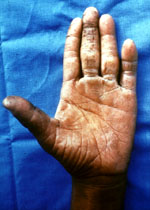Neuropathic Lesions
- NEUROPATHY = NERVE DISEASE.
- Usually accepted as loss of sensory perception.
- It is rare to find only sensory nerves affected.
- Check function of all nerves in the affected limb.
A neuropathic limb may show deficiencies in the function of one or more nerves. Neuropathy is not rare. It frequently shows only a minor nerve dysfunction that is difficult to diagnose. The affected individual may not realize he has 'a problem'. A child born with diminished pain perception does not know a burn should hurt! Does he know what pain really is? Normal people regard paraesthesia as abnormal- but many affected persons never complain as they do not realize that the feeling of 'pins and needles' is 'abnormal'. This helps explain why many persons born with a sensory deficit, are not diagnosed until some major problem draws attention to the fact that the patient obviously does not have as much pain as expected.
Neuropathy is not rare; effects are often neglected because there is no pain.
- Mechanical - trauma, compression
- Infectious - leprosy, polio
- Vascular
- Metabolic - diabetes
- Neoplasm - primary, secondary
- Chemical - drugs, heavy metals
- Developmental - spina bifida
- Heritable disorders - motor/sensory neuropathy, CMT
The post spinal trauma patient usually has some neuropathy; may be complete below the site of the lesion; may be partial. Polio usually only affects the motor nerves, not the sensory, so the Polio patient does not develop the complications caused by loss of sensory nerve function. Vascular lesions may by anoxia damage nerve function and produce bizarre symptoms including excessive pain perception i.e. hyperaesthesia. Some persons think Diabetes is the only cause of neuropathy, which often presents as diminished pain perception, but diabetes is certainly not the only cause of reduced pain perception. Lead poisoning causes wrist drop - motor neuropathy. The heritable disorders are often regarded as 'shameful' so the patient does not volunteer that there is a problem in the family; in fact the patient may not know that there is 'a skeleton in the family closet'. Many families try to hide the inherited problem, and do not tell the younger members of the family that it exists; hence, the growing child does not realize that paraesthesia is a warning that he is developing sensory abnormalities and needs to start to take special care of his hands and feet to prevent deformity or disability. Charcot-Marie-Tooth inherited neuropathy may affect one person only mildly but the next generation may have it severely. If health education of parents and child commence early it is possible to minimize deformity and disability. It is often thought that CMT affects only motor nerves but there is often a sensory deficit that becomes a serious problem when the patient develops an abnormal gait, and then ulcers occur because of excess pressure on areas with reduced pain perception.
hese three boys are in a family in which 5 out of 13 children are affected with familial neuropathy. The older boy in this picture (the one next to his crutches) had already destroyed his feet so that he has no normally shaped foot bone and he is literally walking on 'bags of bones' without normal articulations. The middle boy has painless ulcers on his feet. The other boy had a complicated fracture of tibia into the knee and just kept walking as there was no pain. The knee is now totally disorganized but it is painless and he can still walk.

What comments would you make about this hand if it belong to a patient consulting you? Have a good look before going on. The skin on the long finger is dry and looks cracked. There is excessive callus at the base of that finger and the ring finger. There is also callus on the long finger proximal phalanx and the DIP joint. This callus is typical of the neuropathic hand - due partly to abnormality of autonomic function and partly due to reduced pain perception and excessive pressures while gripping objects. The little finger is not quite straight and it is lying abducted away from the ring finger. The inability to fully adduct the little finger is one of the earliest signs of ulnar nerve dysfunction. An inability to straighten the little finger could also indicate a deficient function of the lumbrical to the little finger. There is a partial wasting of the thenar eminence - does this indicate a median nerve dysfunction? So a hand that on initial, casual examination may be classed as normal shows evidence of possible motor, sensory, and autonomic nerve damage.
Hands of young boy showing difference in ability to abduct and adduct the fingers. There is also some wasting of the hypothenar eminence of the same hand. This boy had leprosy and there was also sensory loss in both ulnar and median nerve distribution. Children with a unilateral neural deficit may show definite retardation of development of the affected hand as compared with the normal hand.
